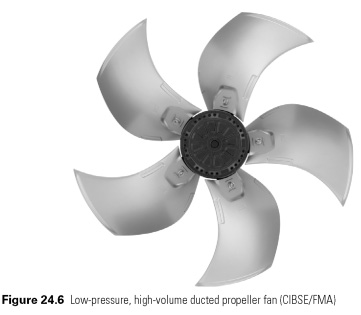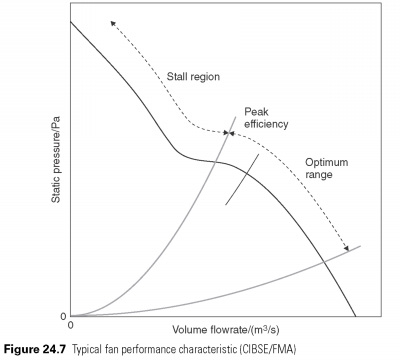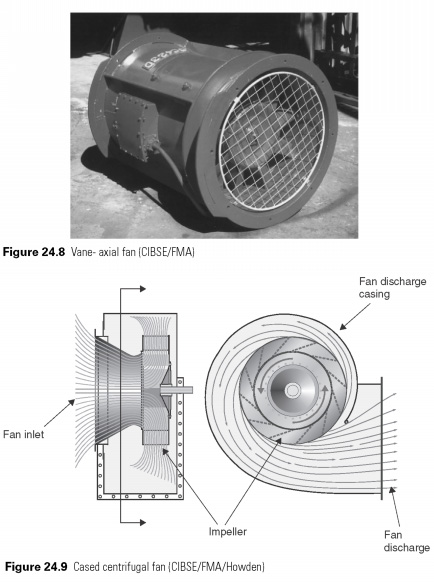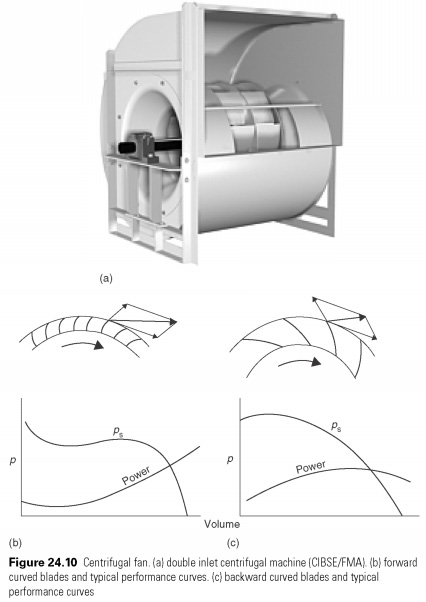Fans
Fans are widely used for air circulation through evaporators and condensers and air-conditioning systems. They can be divided into two types: axial and centrifugal. Axial fan blades creation of aerodynamic lift that causes the blades to give the force of air, propelling it forward. Low pressure high volume propeller fan (Fig. 24.6) are used in combination with heat exchangers, such as evaporators and condensers. They move large volumes of air to create low pressures. Efficiency is improved by tight entrance of the shroud. Some blade type specifically designed to reduce noise.

Other axial types that are used for air circulation in ducts include vane-axial, which has good downstream distribution of the air and the tube axis. Typical performance axial blower characteristic is shown in Fig. 24.7 . Fan curves have the volume flow rate on the x-axis and development pressure on the y-axis. The fan should be chosen as the next effectively as possible. When the fan is in a stable region there is a failure in performance due to turbulence and it can lead to increased noise levels.

Vane-axis and tube axial type are used in air conditioning.
- Fan-axial type, straightening vanes are used at the output of the impeller, tube-axis (Fig. 24.8) are used where the distribution of the air downstream of the fan is not critical.
Centrifugal fans (Figure 24.9) rotate in the air and use centrifugal force to create the air stream. They can generate significantly more pressure than an axial fan. Most centrifugal fans are working in the body, and it is used to recover a significant part of the kinetic energy of the flow leaving the impeller, turning it into a static pressure. Air, leaving the ends of the blades with a radial and tangential velocity, so the shape of the blade determines the performance of the fan. Forward curved blades of the fan increases the tangential velocity significantly (see Fig. 24.10(b)). As a result, the power required increases with increasing mass flow, although the external pressure low impedance and larger drive motors required if the resistance of the system can change into operation. In the backward curved fan has a flatter curve power, as the air leaves the blade is less than the velocity (see Fig. 24.10(c)). This is the most effective type.

Durable nature impeller makes the centrifugal fan is much more tolerant to disruption of work compared with axial type, providing almost the same pressure/volume even when the cab is encountered. However, they should not be operated in a stall because of pressure fluctuations.
The cross flow type has impellers are similar to those of the multi-vane forward curved centrifugal, but the action is different. Vortex is formed on the blade forces and has its axis parallel to the shaft and close to the impeller of the circle.

Low efficiency, but these fans are relatively quiet. Its particular form is very suitable for many types of air handling units such as fan coil units and fan coil units.
Fan efficiency depends on the distance of the flight and it is therefore important to make sure that the fan is correctly selected. The overall efficiency of the fan electrical power input compared with air power output. Specific fan power (SFP)is defined as the authority in terms of watts per liter of air per second delivered. It is usually not quoted, because value depends on the position of the curve fan. SFP affects the design of the system is decreased resistance of the system, giving the following SFP. It is used as a limiting the number of fans power consumed in the building and takes into account any additional losses, such as variable speed drives...
|




